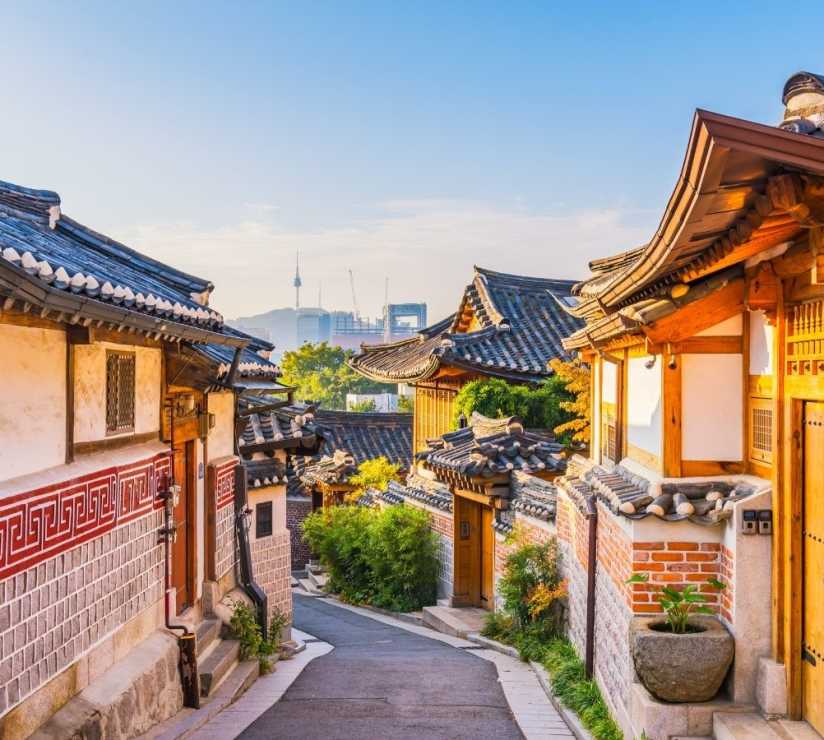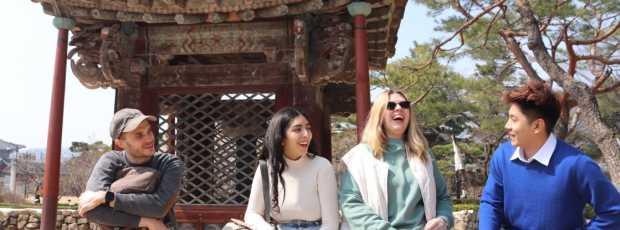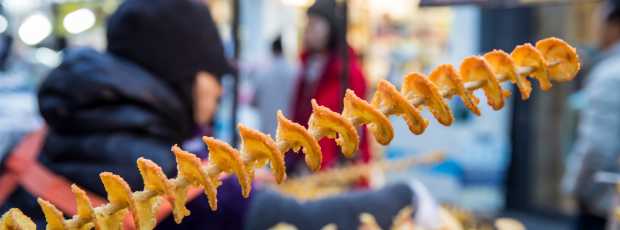Table Of Contents
- Why a Week in Seoul Makes Perfect Sense
- Getting Your Bearings: First 48 Hours in Central Seoul
- Days 3-4: Beyond Tourist Seoul
- Day 5: Day Trips from Seoul
- Days 6-7: Hidden Seoul and Local Favorites
- Understanding Seoul's Cultural Rhythm
- Practical Details for Your Seoul Week
- The Seoul That Stays With You
Seoul rewards the curious traveler. Beyond the obvious tourist stops lies a network of hidden neighborhoods, tucked-away coffee shops, and experiences that feel genuinely Korean. After countless walks through these streets, I've learned that the best way to experience South Korea's capital isn't by checking boxes, it's by letting the city surprise you.
Why a Week in Seoul Makes Perfect Sense
Is seven days too much in Seoul? Not even close. I've watched visitors rush through in three days, hitting Gyeongbokgung Palace, Myeongdong, and calling it done. They miss the Seoul that locals actually live in.
A week gives you time to breathe. You can explore Bukchon Hanok Village in the morning when the light hits the traditional Korean houses just right, then spend the afternoon discovering why N Seoul Tower looks different from every neighborhood. You can take that day trip to the DMZ without feeling rushed, knowing you'll still have time to wander through Gwangjang Market later.
The rhythm of Seoul reveals itself over days, not hours. Coffee shop culture here moves at its own pace. The way people gather along the Han River changes with the weather. Street food vendors have their own schedules, and some of the best Korean BBQ places don't even open until evening.
Getting Your Bearings: First 48 Hours in Central Seoul
Day 1: Palace Hopping with Purpose
Start at Gyeongbokgung Palace, but not when the tour buses arrive. I go at opening time, 9 AM, when the palace grounds feel almost meditative. The changing of the guard ceremony happens three times daily, and the morning one draws smaller crowds.
The National Folk Museum sits within the palace complex, offering context that makes the rest of your week richer. Traditional Korean life comes alive through artifacts and reconstructed homes. Spend about an hour here before the tour groups descend.
Walk north from Gyeongbokgung to Bukchon Hanok Village. This neighborhood preserves traditional Korean houses alongside modern life. The Instagram spots are obvious, but I prefer the quieter alleys where residents still hang laundry and tend small gardens. The contrast between old and new defines Seoul, and Bukchon Hanok Village shows this better than anywhere else.
For lunch, skip the tourist restaurants. Find a local spot serving Korean cuisine, maybe Korean dumplings or bibimbap. Ask your server for recommendations. Korean culture values hospitality, and you'll often get insider tips just by showing genuine interest.
Where Should You Stay in Central Seoul?
Myeongdong puts you within walking distance of major attractions, but I prefer neighborhoods with more local character. Jung-gu offers easy access to palaces and markets. Hongdae brings you closer to Seoul's creative energy. Each area offers different windows into Korean culture.
Day 2: Markets, Museums, and Mountain Views
Begin at Gwangjang Market, one of Seoul's largest traditional markets. Arrive hungry. The Korean street food here spans generations, some vendors learned recipes from grandparents who sold food during the Japanese occupation. Try bindaetteok (mung bean pancakes) from the same stalls that have been here for decades.
The delicious street food at Gwangjang represents more than just eating, it's a social experience. Sit at the small plastic stools, watch the organized chaos of the kitchen, and observe how locals interact with vendors they've known for years.
Afternoon calls for perspective. N Seoul Tower offers the classic city view, but the journey up matters as much as the destination. Take the cable car from Myeongdong. The ride provides views of the city walls that once protected the old capital, now threading between modern neighborhoods.
Seoul Tower itself serves as more than a viewpoint. The observation decks show you the geography that shapes daily life here, how the Han River divides the city, where the mountains create natural boundaries, why certain neighborhoods developed where they did.
Looking for a private city experience in Seoul?
Explore the city with a local who plans a private day just for you; no groups, no scripts.
Days 3-4: Beyond Tourist Seoul
What's the Best Way to Experience Korean Food Culture?
Food in Seoul extends far beyond Korean BBQ, though you should definitely try that too. I recommend dedicating a full day to eating your way through different neighborhoods. Each district has its own food personality.
Start in Gangnam (yes, like the song) for upscale Korean cuisine. The restaurants here push traditional boundaries while respecting classical techniques. Try a Korean spa treatment afterward, these Korean bathhouses integrate food, relaxation, and social interaction in uniquely Korean ways.
Move to Itaewon for international flavors that reflect Seoul's growing diversity. Korean-Mexican fusion might sound strange, but it works here. The neighborhood hosts a significant expat community, creating food combinations you won't find elsewhere.
Exploring Seoul's Creative Districts
Hongdae pulses with energy from nearby universities. Street art covers walls and underpasses. Independent coffee shops occupy spaces that might house chain stores elsewhere. Live music spills from clubs and small venues most nights of the week.
The neighborhood rewards wandering. Art galleries hide in basement spaces and converted warehouses. Some of Seoul's most interesting visual artists show work here before moving to more established venues.
Gangnam Style might have made this district famous internationally, but locals know it for high-end shopping and innovative architecture. The Gangnam Style statue draws tourists, but spend time in COEX Mall and the surrounding area to understand Seoul's economic ambitions.
Day 5: Day Trips from Seoul
How Far Can You Go in One Day?
Seoul's location on the Korean Peninsula offers compelling day trip options. The DMZ (Demilitarized Zone) separating North and South Korea sits about an hour north of Seoul Station. Tours here provide sobering context about the Korean War and ongoing division.
Book DMZ tours in advance. The experience involves security checks and restricted movement, but seeing the border between North Korea and South Korea firsthand adds gravity to your understanding of Korean history. The contrast between Seoul's prosperity and the tension at the border puts the city's remarkable development into perspective.
For a lighter day trip, consider Bukhansan National Park. Seoul surprises visitors with how quickly urban density gives way to serious mountains. Hiking trails here range from gentle walks to challenging climbs, all within reach of the subway system.
The park showcases a different side of Korean culture, the deep connection between urban Seoulites and natural spaces. Weekend mornings bring families equipped with serious hiking gear, turning mountain climbing into social occasions.
What About Transportation?
Get a T Money Card on your first day. Seoul's subway system connects virtually everywhere you'll want to go, including Incheon International Airport. Google Maps works perfectly for navigation, showing real-time train schedules and walking directions.
The subway also offers cultural immersion. Rush hour showcases Seoul's work culture. Late-night trains reveal the city's social rhythms. Weekend afternoons show families heading to parks or shopping districts. Each ride provides small insights into how this city actually functions.
Days 6-7: Hidden Seoul and Local Favorites
Where Do Locals Actually Go?
After five days hitting major sites, dedicate your remaining time to places that locals frequent. The Gyeongui Line Forest Park transforms an old railway into a green corridor through dense neighborhoods. It's not spectacular, but it's real, the kind of space where people walk dogs, kids play, and couples meet for coffee.
Seoul's coffee shop culture deserves its own exploration day. Places like Green Mile Coffee represent the serious approach Korean baristas take toward their craft. These aren't Starbucks alternatives, they're destinations where coffee preparation becomes performance art.
Try visiting convenience stores, which in Seoul function as informal community centers. They're open 24/7, stock fresh meals alongside snacks, and provide wi-fi and seating. Locals treat them as extension of their kitchens, especially in neighborhoods where space comes at a premium.
What Makes Seoul's Neighborhoods Unique?
Each district has developed its own personality over decades. Myeongdong focuses on shopping and street food, but step into side streets for quieter restaurants and traditional tea houses. The Myeongdong Night Market comes alive after dark, offering Korean street food alongside beauty products and clothing.
Dongdaemun Design Plaza represents Seoul's architectural ambitions, a swooping, futuristic building that houses fashion exhibitions and design markets. The surrounding area operates on a different schedule, with wholesale markets opening before dawn and staying active through the night.
Visit during different times of day to understand how neighborhoods shift. Morning reveals commuters and school children. Afternoon brings shoppers and cafe culture. Evening transforms streets with restaurant lights and social energy. Late night shows a different Seoul entirely, one focused on food, drinks, and conversations that stretch toward dawn.
Where Should You End Your Week?
Your final day deserves a neighborhood that captures Seoul's complexity. I suggest northern Seoul, where mountains meet city development. Take the cable car up to different viewpoints, but spend most of your time walking through residential areas.
These areas show how Seoul adapts to geography. Buildings climb hillsides in ways that would be impossible in flatter cities. Small shops and restaurants serve specific neighborhoods rather than tourists. The pace slows slightly, though never completely stops.
Find a local restaurant for Korean fried chicken or traditional stews. Watch how families gather for meals, how friends share drinks, how the social fabric of Seoul weaves itself together through food and conversation.
What if your day in Seoul was planned by someone who knows it — and you?
City Unscripted matches you with a local host who creates a private experience based on your interests, not a set route.
Understanding Seoul's Cultural Rhythm
How Does Korean Culture Shape Daily Life?
Seoul operates on principles that might seem contradictory to visitors. The city moves fast but values patience. People work long hours but prioritize social time. Modern technology coexists with traditional practices in ways that feel natural rather than forced.
Korean beauty products represent this balance. High-tech skincare meets traditional ingredients. Shopping districts like Myeongdong Shopping Street showcase this blend, global brands sharing space with local innovations.
The changing of the guard ceremony at palaces demonstrates how Seoul maintains connections to Korean history while embracing contemporary life. These performances happen multiple times daily, but each feels meaningful rather than routine.
What About Shopping and Nightlife?
Seoul's shopping ranges from massive malls to tiny specialty stores. COEX Mall stretches underground, connecting subway stations and office buildings. But I prefer neighborhood markets where vendors know regular customers and prices reflect local rather than tourist demand.
Nightlife here starts late and ends later. Restaurants often don't hit their stride until 9 PM. Bars and clubs peak around midnight. This schedule aligns with Korean work culture, long days followed by social evenings that help maintain relationships.
Korean spa culture offers a different kind of evening activity. These bathhouses provide spaces for relaxation and socializing that don't revolve around alcohol. Families use them together. Friends meet there for regular catchups. They represent Korean approaches to health and community that predate Seoul's rapid modernization.
Practical Details for Your Seoul Week
How Much Money Do You Need for a Week in South Korea?
Budget varies significantly based on accommodation and dining choices. Mid-range hotels cost 80,000-150,000 won per night. Street food meals run 5,000-10,000 won. Sit-down restaurant meals range from 15,000-50,000 won per person.
Transportation stays relatively inexpensive. Subway rides cost around 1,400 won. Buses charge similar rates. Taxis cost more but remain reasonable for short distances. Day trip costs vary, DMZ tours run 100,000-200,000 won including transportation and guide.
How Long Can US Citizens Stay in Seoul?
US citizens can visit South Korea visa-free for up to 90 days. Your passport needs at least six months of validity remaining. Seoul's Incheon International Airport handles immigration efficiently, usually processing arrivals within 30-45 minutes.
What Should You Pack for Seoul?
Seoul's weather varies dramatically by season. Spring brings cherry blossom season and mild temperatures perfect for walking. Summer means heat, humidity, and occasional heavy rain. Fall offers comfortable weather and beautiful colors in the mountains. Winter brings serious cold but also clear skies great for photography.
Comfortable walking shoes matter more than fashion. Seoul involves significant walking, often on hills and stairs. Layers work better than heavy coats. An umbrella handles both sun and rain depending on the season.
The Seoul That Stays With You
What Will You Remember Most?
After countless conversations with visitors, certain Seoul experiences stick longest in memory. It's rarely the famous attractions, though those matter too. Usually, it's smaller moments, the kindness of strangers helping with directions, the taste of street food discovered by accident, the view from a random coffee shop that perfectly frames the city.
Seoul rewards attention to detail. The way morning light hits the Han River. How N Seoul Tower looks different from every angle. The sounds of Gwangjang Market at different times of day. The pride vendors take in explaining their food. These details accumulate into understanding.
Why Does Seoul Work So Well for a Week-Long Visit?
This city operates at human scale despite its size. Neighborhoods have distinct personalities you can explore on foot. Public transportation makes everything accessible. The mix of traditional and modern provides constant discovery without feeling overwhelming.
Seoul also rewards return visits. A week gives you foundation knowledge but raises more questions than it answers. You'll leave knowing which neighborhoods deserve deeper exploration, which restaurants you want to try again, which experiences you want to share with friends.
The traditional Korean houses of Bukchon Hanok Village will look different after you've spent time in modern Gangnam. Korean food tastes more complex after you understand the stories behind specific dishes. The secret garden of Changdeokgung Palace means more when you've experienced Seoul's contemporary green spaces.
Planning Your Next Visit to Seoul
Most people who spend a week visiting Seoul start planning their return before leaving. This city has that effect. It's complex enough to reward multiple visits, friendly enough to make you feel welcome, and dynamic enough that it's always changing.
Whether you're interested in Korean culture, urban exploration, food adventures, or just experiencing a vibrant city that successfully balances tradition with innovation, Seoul delivers. A week provides the perfect introduction, long enough to go beyond surface attractions, short enough to maintain energy and curiosity throughout.
If you're planning your first visit to Seoul, this city will surprise you. If you're returning, it will surprise you again. That's what makes Seoul special, it reveals itself gradually, rewarding patience with discovery. Take your time, stay curious, and let the city show you what makes it unique.
The question isn't whether seven days is enough time in Seoul, it's whether you'll be able to leave after experiencing what this remarkable city has to offer. From traditional Korean life preserved in palace museums to cutting-edge design in modern districts, from street markets serving food recipes passed down through generations to coffee shops pushing the boundaries of their craft, Seoul offers depth that rewards extended exploration.
Plan your week, but stay flexible. Seoul's best discoveries often happen when you're not looking for them. That's the kind of city it is, one that rewards the curious traveler with experiences that last long after you've returned home.
For more comprehensive planning resources, explore our detailed Seoul travel guides. And if you're looking for personalized local experiences during your week in Seoul, check out our curated Seoul experiences led by knowledgeable local guides who can show you the city through insider perspectives.
Your week in Seoul awaits. Pack light, bring curiosity, and prepare for a city that will change how you think about urban travel.
Tip
We match you with the right host, not just any guide.Want to experience the real Seoul with someone who lives there?
A fully private experience, planned and led by a local host who tailors the day to you
Ready to plan your perfect day in Seoul?
Start your experienceWhat if your day in Seoul was planned by someone who knows it — and you?
City Unscripted matches you with a local host who creates a private experience based on your interests, not a set route.
Want to experience the real Seoul with someone who lives there?
A fully private experience, planned and led by a local host who tailors the day to you











